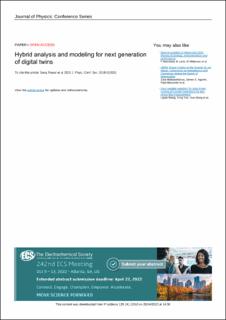| dc.contributor.author | Pawar, Suraj | |
| dc.contributor.author | Ahmed, Shady E | |
| dc.contributor.author | San, Omer | |
| dc.contributor.author | Rasheed, Adil | |
| dc.date.accessioned | 2022-04-20T14:17:12Z | |
| dc.date.available | 2022-04-20T14:17:12Z | |
| dc.date.created | 2021-09-23T22:50:09Z | |
| dc.date.issued | 2021 | |
| dc.identifier.citation | Journal of Physics: Conference Series (JPCS). 2021, 2018 . | en_US |
| dc.identifier.issn | 1742-6588 | |
| dc.identifier.uri | https://hdl.handle.net/11250/2991709 | |
| dc.description.abstract | The physics-based modeling has been the workhorse for many decades in many scientific and engineering applications ranging from wind power, weather forecasting, and aircraft design. Recently, data-driven models are increasingly becoming popular in many branches of science and engineering due to their non-intrusive nature (i.e., they are equation-free) and online learning capability. Despite the robust performance of data-driven models, they are faced with challenges of poor generalizability and difficulty in interpretation. These challenges have encouraged the integration of physics-based models with data-driven models, herein denoted hybrid analysis and modeling (HAM). We propose two different frameworks under the HAM paradigm for applications relevant to wind energy in order to bring the physical realism within emerging digital twin technologies. The physics-guided machine learning (PGML) framework reduces the uncertainty of neural network predictions by embedding physics-based features from a simplified model at intermediate layers and its performance is demonstrated for the aerodynamic force prediction task. Our results show that the proposed PGML framework achieves approximately 75% reduction in uncertainty for smaller angle of attacks. The interface learning (IL) framework illustrates how different solvers can be coupled to produce a multifidelity model and is successfully applied for the Boussinesq equations that govern a broad class of transport processes. The IL approach paves the way for seamless integration of multi-scale, multi-physics and multi-fidelity models (M3 models). | en_US |
| dc.language.iso | eng | en_US |
| dc.publisher | IOP Publishing | en_US |
| dc.rights | Navngivelse 4.0 Internasjonal | * |
| dc.rights.uri | http://creativecommons.org/licenses/by/4.0/deed.no | * |
| dc.title | Hybrid analysis and modeling for next generation of digital twins | en_US |
| dc.type | Peer reviewed | en_US |
| dc.type | Journal article | en_US |
| dc.description.version | publishedVersion | en_US |
| dc.source.pagenumber | 10 | en_US |
| dc.source.volume | 2018 | en_US |
| dc.source.journal | Journal of Physics: Conference Series (JPCS) | en_US |
| dc.identifier.doi | 10.1088/1742-6596/2018/1/012031 | |
| dc.identifier.cristin | 1937935 | |
| dc.relation.project | Norges forskningsråd: 268044 | en_US |
| cristin.ispublished | true | |
| cristin.fulltext | postprint | |
| cristin.qualitycode | 1 | |

